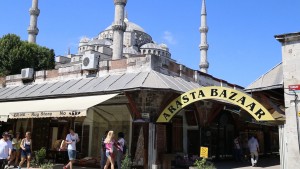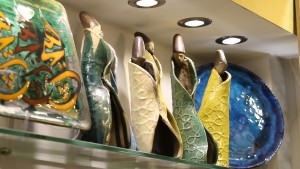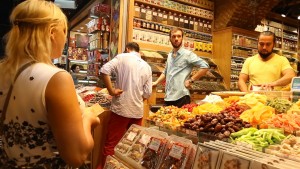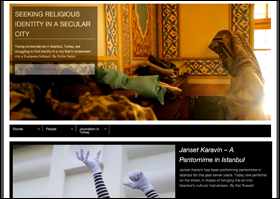Civilized Shopping
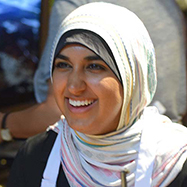
- Mashal Noor
- On July 28, 2015
It’s strictly soft sell at the Sultanahmet’s Arasta Bazaar.
Hidden in Istanbul’s Sultanahmet district is the Arasta Bazaar, an elegant tourist market with a much calmer vibe than the more frenetic and better-known Grand and Spice bazaars.
As in its bigger brethren, in Arasta you’ll find carpets, textiles, towels, scarves, felt hats and organic soaps. But unlike in the other markets, nobody cajoles or pressures you. One of the unwritten rules of Arasta is to let customers make buying decisions on their own. So while customers shop, the vendors sit outside their stores, talking, smoking and drinking tea.
“In the Spice Bazaar, everyone is hassling the customers in the bazaar, and they are focused on how they can get the people’s money,” said Abdurrahman Kaya, owner of the modern art shop Art East. “Here, it’s very quiet, and nobody disturbs the customers.”
The vendors, many of them related, also foster a less cutthroat, and more collectivist, culture.
“We [the shop owners] support each other all the time, because we are like one team – we do everything together,” said Ahmet Kaya, Abdurrahman’s uncle and the owner of Istanbulin, a textile, towel and organic soap shop.
Arasta has only 70 stores, compared to the Grand Bazaar’s 3,000 and the Spice Bazaar’s 90, but the Arasta shops focus on high-quality and designer products. The market is a short walk from Sultanahmet Park, away from the crowds surrounding the Blue Mosque and Hagia Sofia, and beside a sea of red and white awnings.
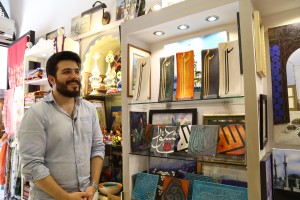
Noticing there were few such shops in Istanbul, Abdurrahman Kaya decided to open a store devoted to the sale of modern art.
During the later years of the Ottoman Empire, the building was used as a stable. After the emergence of the Turkish Republic in 1923, it fell into ruin. But in 1987, as tourism interest in Turkey began to climb, and the Blue Mosque was being restored, the government decided that the rent payments from the Arasta shops would go toward funding maintenance and repairs of historical sites around Turkey.
Sabri Sevim, owner of Doruk Art Gallery, said he liked that idea.
“This makes me happy, because I know where my money is going,” he said.
Many of the Arasta’s current proprietors, Sevim included, set down roots at the start.
“Artists seek out the shops in Arasta, because they know the type of customers the bazaar gets,” Sevim said.
“This bazaar isn’t covered like the Grand Bazaar and Spice Bazaar, so we can have fresh air all of the time,” said Ahmet Kaya. “It’s like a walking street in Europe.”
Istanbulin has been in the Kaya family for over 25 years; Ahmet took over management of the shop after his father retired.
Abdurrahman spent five years working in the Spice Market, then opened Art East to be closer to his family, and to work in a new environment.
“When I was in the Spice Bazaar, I had to change the way I acted with the customers. Here, I can be myself, though,” he said. “In the Spice Bazaar, everyone is hassling the customers in the bazaar and they are focused on how they can get the people’s money. Here, it’s very quiet and nobody disturbs the customers.”
Margot Simon, a tourist from France said, “I enjoyed the Arasta Bazaar most in Istanbul. I feel much more relaxed here, and can make decisions on what to buy a lot easier. The shop owners are very nice and friendly, so it is a much more pleasant experience when I buy something.”
The Arasta shop owners say they also get along better with one another than proprietors in the other markets do.
“The Spice Market is like a war zone,” Abdurrahman said. “ It is especially that way because all of the shops in the Spice Market sell the same thing, and here, everyone sells different things.”
“But of course, like other bazaars, this one also has competition,” he added.
Some of the shops also appeal to customers because of their more unusual wares. Sevim’s Doruk Art Gallery focuses on Ottoman-era artwork and replicas. He also works closely with a talented Turkish painter, Cemal Toy. Sevim has set himself apart, because he specializes in something he likes: modern art.
Art East sells handmade jewelry, paintings and ceramics. Abdurrahman said he works with over 20 well-known Turkish ceramic designers and painters, and requests specific work from them.
“I sell designer pieces that are more unique and unusual, so my prices are a little higher than normal,” Abdurrahman said.
Abdurrahman noticed the lack of modern art in Istanbul, and decided to fill in that space with the products that he carries in his own shop.
He opened Art East just over a year ago, and has been adapting to all of the responsibilities that come with owning his own shop, such as paying for his own rent, electricity and taxes.
“I was working in the Spice Market, so I didn’t care about anything other than my work,” he said, “But this bazaar is better than the Spice Market. It’s quieter and more peaceful, so life is much easier for me in this bazaar.”
Video
© 2015 ieiMedia / All rights reserved




